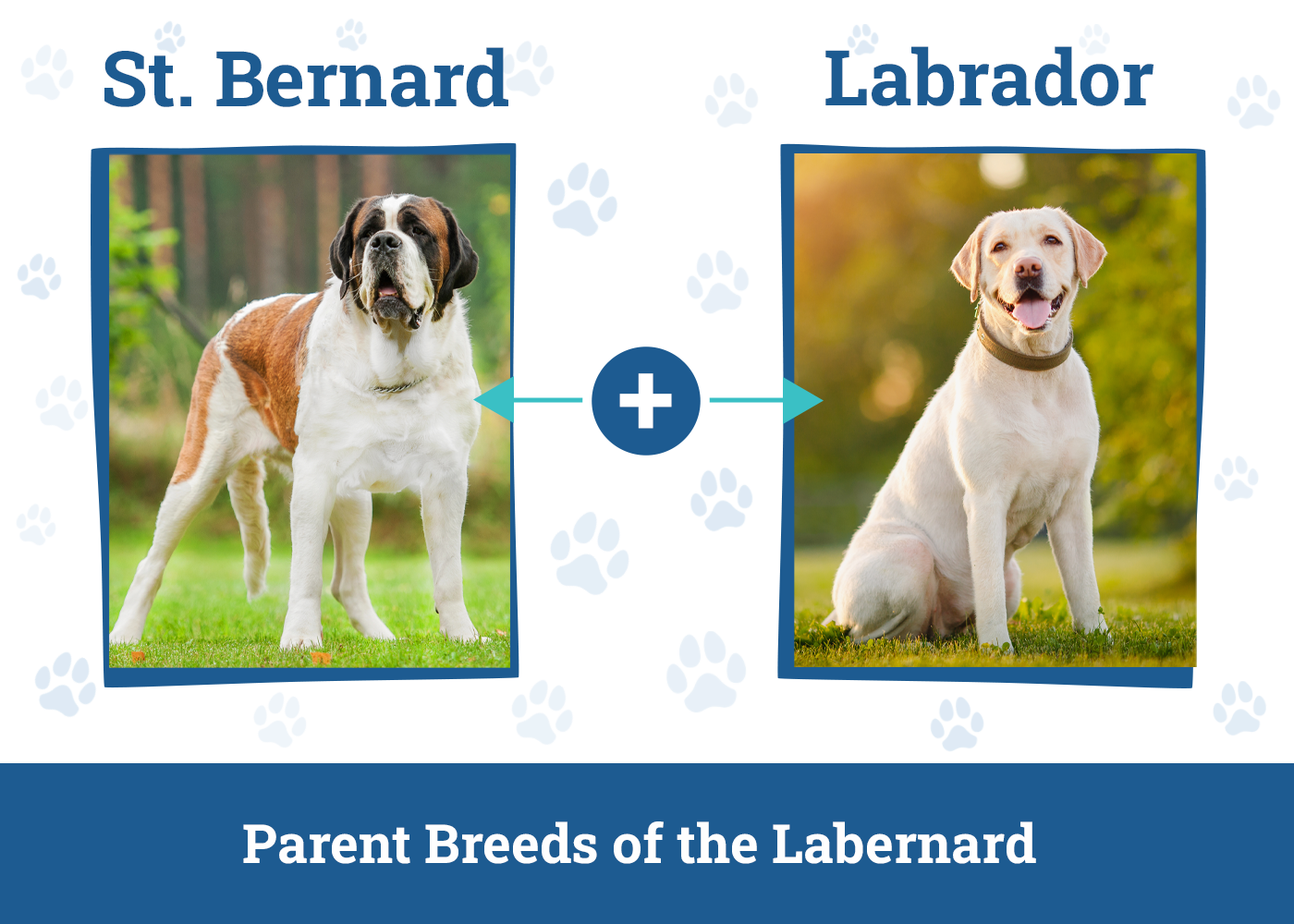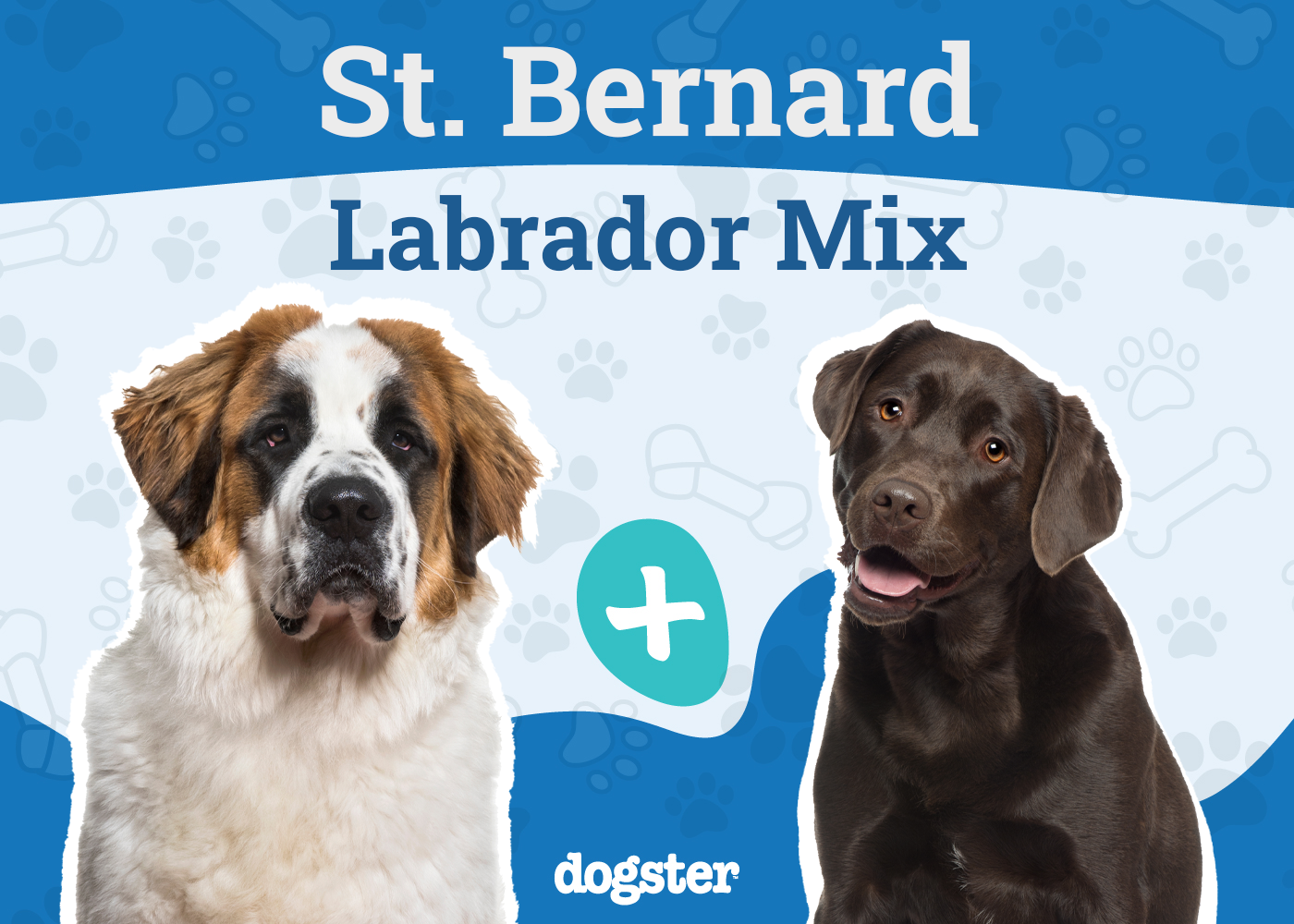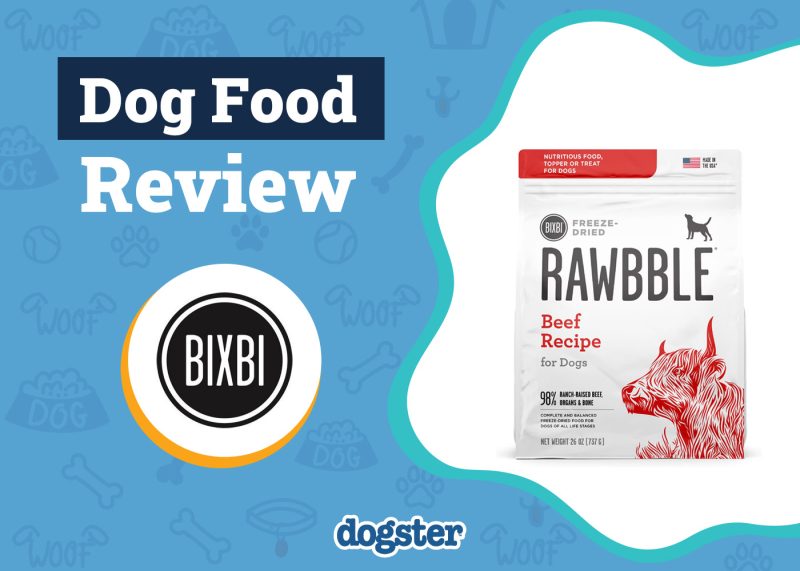In this article
View 8 More +A Labernard is a Labrador Retriever mixed with a St. Bernard. Some people call this designer breed a Bernador, but that can get a little tricky since the term can also refer to a Labrador that’s mixed with a Bernese Mountain Dog. Since St. Bernards and Labrador Retrievers are both friendly, family-oriented dogs, you can expect this mix to be terrific with children, low-key, and ready to call you their new best friend.
Breed Overview
Height:
21–30 inches
Weight:
55–180 pounds
Lifespan:
8–14 years
Colors:
Black, brown, cream, red, white
Suitable for:
Families with small children, someone who has time to play
Temperament:
Loyal, loving, easy to train, friendly, gets along with other pets
According to the American Kennel Club, the Labrador Retriever scored as the top dog in the United States from the 1980s until they were usurped by the French Bulldog in 2023. Like the Labrador, the St. Bernard is also very familiar with the family hearth. Often endearingly nicknamed “Gentle Giants,” the St. Bernard has worked as a calm, loyal “nanny” dog for hundreds of years. The traits that both breeds have that work well for family life are combined and strengthened in the Labernard, making them an excellent choice.
Labernard Characteristics

Labernard Puppies
Mixed breeds are a bit trickier to define and find than well-established purebred dogs. Since Labernards are a mixed breed without a breed standard, you could go about acquiring them one of two ways: you can try to find a reputable breeder or adopt from the shelter.
Public perception dictates whether you pay thousands of dollars for a “designer breed” like the ravenously popular Labradoodle or simply pay an adoption fee for a “mutt” that you might find at the shelter. The honest truth is that you could pay more for a dog or adopt one for less and end up with a charming new friend either way. Rescuing a Labernard from a shelter or other animal organization may take more time to find, but in the end, it saves a life and prevents you from spending a fortune upfront. If you do decide to go the breeder route, make sure both parents are certified by a respected breed organization, such as the American Kennel Club, and screened for genetic health conditions. You should also always be allowed to meet the parents. A breeder who refuses to let you see the puppy’s parents often runs a puppy mill or is trying to scam you.


Temperament & Intelligence of the Labernard
The Labrador and the St. Bernard are both known for their loyalty and their generally calm nature. They’re very friendly and aren’t known for being aggressive towards people or other animals. Although the exact temperament will vary from dog to dog, you can generally expect the Labernard to be very loyal, loving, and friendly as well.
Both the Labrador and the St. Bernard are working dogs, so they are very intelligent and easy to train. The Labernard should be highly trainable, but it’s important to note that you must provide plenty of mental stimulation to keep them from getting bored. However, the bottom line is that you won’t have to worry about a Labernard having a bad temperament, as these are amazing dogs overall, thanks to their parent breeds.
Are These Dogs Good for Families? 👪
The Labernard is the perfect candidate for a family lifestyle. Since they’ve inherited the athletic prowess of the Labrador, they’re likely to love to run, swim, and play dog sports. However, the laid-back nature of the St. Bernard calms them down when it’s time for a nap or to chill indoors. While both parent breeds are known to be gentle and patient towards children, it’s always important to teach children appropriate boundaries to help everyone get along, such as not pulling on their tails or antagonizing them.
Does This Breed Get Along With Other Pets? 🐶 😽
With early socialization training, Labernards will likely get along with other pets. They don’t possess the high prey drive that makes some breeds dangerous for cats, such as Huskies. However, it’s best to acquaint them with other animals at a young age and adopt a puppy or kitten as opposed to a fully grown animal to help them adjust.

Things to Know When Owning a Labernard
Food & Diet Requirements 🦴
Weighing up to 180 pounds, a Labernard chows down on a ton of food every day. While it might be tempting to buy the least expensive food available in order to cut down on their enormous grocery bill, you should always talk to your vet about what your Labernard needs in order to eat a well-balanced diet. Like junk food for humans, cheaper dog food is often less nutritionally filling—which puts your pup at risk of developing health problems. Plus, they’ll need to eat more to stay full, which counteracts the cost-cutting aspect of a less expensive meal.
Exactly how much your Labernard eats every day depends on individual factors such as their health, weight, age, and activity level. On average, though, you can expect to feed them somewhere between 3 and 6 cups of dry food each day.
Exercise 🐕
Labernards need between 30 minutes to an hour of daily exercise to stay healthy. Since they form close attachments to their people, they’ll likely enjoy a game of frisbee or ball or volunteer to go with you on a walk or run. The Labrador in their veins may also compel them to jump in the pool to go for a swim.
Training 🎾
Training always takes patience and persistence. Thankfully, though, both the St. Bernard and Labrador Retriever are eager to please. Some Labradors, in particular, may possess a curiously independent stubborn streak that can prove challenging to training sessions. If this is the case, breaking up training sessions into shorter lessons can help retain their attention. Be sure to give plenty of positive reinforcement, including training treats, and exercise them first so your Labernard isn’t feeling overly hyper or distracted.

Grooming ✂️
Both parent breeds have a double coat, but genetics determine whether your Labernard pup will inherit the thicker fur from the St. Bernard or the slick short coat from the Labrador. Brush them several times a week and keep a lint roller handy, especially during shedding season in the spring and fall. Be sure to keep an eye on their ears, cleaning them as needed to prevent infections and drying them after getting wet.
Health and Conditions 🏥
Unfortunately, large breeds don’t tend to live as long as smaller breeds. Their extra weight puts stress on their joints, especially if they’re overweight, and their stomachs are more likely to bloat and twist due to their deeper chest cavities. All hope isn’t lost, however. This just means that it’s more important than ever to keep their weight in check and feed them balanced diets. Plus, Labernards have an advantage over their purebred parents because recent studies are finding that crossbreeds may live longer. You can expect your Labernard to live between 8–14 years but hope for the upper end with consistent, loving care.
For example, to reduce the risk of gastric torsion, you should feed them a couple of small meals instead of a giant feast and wait at least an hour after mealtime before letting them romp around. It turns out that what our parents told us about waiting to go swimming after eating can save your dog’s life. And, of course, going to the vet at least once a year for a wellness visit can answer any questions you have about caring for your pet and catch any possible health problems early.
Some breed-specific, minor issues that your Labernard may deal with include skin problems and ear infections. These aren’t major deals, but they can still cause your pup some discomfort. You can talk to your vet about ways to deal with your dog’s skin condition, such as eliminating certain foods or taking allergy medication if environmental allergies may be suspected. Make sure to clean their ears regularly to reduce the risk of ear infections.
- Skin problems
- Ear infections
- Gastric torsion
- Obesity
- Cancer
Male vs Female
A female Labernard will likely be much smaller than a male, weighing between 55–140 pounds as opposed to tipping the scale at 65–180 pounds. Other than size, the biggest differences boil down to individual personalities instead of gender.

3 Little-Known Facts About the Labernard
1. Labernards Make Excellent Service Dogs
Labradors and St. Bernards have saved countless lives and improved many more. Both parent breeds are popularly trained as service dogs, so we can imagine that their crossbreed would make an excellent candidate as a guide dog or emotional support animal.
2. Labernards Love to Search
Labradors were initially bred to retrieve waterfowl, while St. Bernards were skilled mountain rescue dogs that pulled people out of devastating avalanches in the Swiss Alps. These breeds bring their inquisitive natures to the Labernard, who probably would love nothing more than nosing through a treat puzzle or playing a “treasure hunt” with you and their favorite toy.
3. Labernards Love to Get Wet
St. Bernards traditionally grew up in snowy weather, while the Labrador dove in streams. Be forewarned: your Labernard may eagerly eye your pool during their backyard adventures or veer towards a body of water when on a hike.

Final Thoughts
Labernards are an amiable mix of positive traits such as sociability, calmness, and eagerness to please. Although they’d get along with anyone, they’re the best fit for families or someone with time to spend with them and a big living space where they won’t bump into the furniture. As a large or giant-sized dog, Labernards have more health concerns than small dogs but can live 8–14 years with proper care.
See also:
- Russian Spaniel: Info, Pictures, Facts, & Traits
- Prazsky Krysarik: Dog Breed Info, Pictures, Care, Traits & More
Featured Image Credit: Connie Sinteur, Shutterstock


















